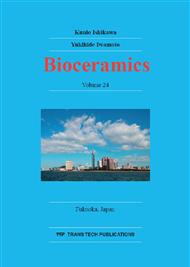p.138
p.143
p.147
p.153
p.157
p.161
p.167
p.173
p.178
Characterization of α/β-TCP Based Injectable Calcium Phosphate Cement as a Potential Bone Substitute
Abstract:
Calcium phosphate cements (CPCs) can be a suitable scaffold material for bone tissue engineering because of their osteoconductivity and perfect fit with the surrounding tissue when injected in situ. However, the main disadvantage of hydroxyapatite (HA) forming CPC is its slow degradation rate, which hinders complete bone regeneration. A new approach is to use hydraulic apatite cement with mainly α/β-tricalciumphosphate (TCP) instead of α-TCP. After hydrolysis the α/β-TCP transforms in a partially non-absorbable HA and a completely resorbable β-TCP phase. Therefore, α-TCP material was thermally treated at several temperatures and times resulting in different α/β-TCP ratios. In this experiment, we developed and evaluated injectable biphasic calcium phosphate cements (BCPC) in vitro. Biphasic α/β-TCP powder was produced by heating α-TCP ranging from 1000-11250°C. Setting time and compressive strength of the CPCs were analyzed after soaking in PBS for 6 weeks. Results demonstrated that the phase composition can be controlled by the sintering temperature. Heat treatment of α-TCP, resulted in 100%, 75% and 25% of α-to β-TCP transformation, respectively. Incorporation of these sintered BCP powder into the cement formulation increased the setting time of the CPC paste. Compressive strength decreased with increasing β-TCP content. In this study, biphasic CPCs were produced and characterized in vitro. This injectable biphasic CPC presented comparable properties to an apatitic CPC.
Info:
Periodical:
Pages:
157-160
Citation:
Online since:
November 2012
Keywords:
Price:
Сopyright:
© 2013 Trans Tech Publications Ltd. All Rights Reserved
Share:
Citation:


